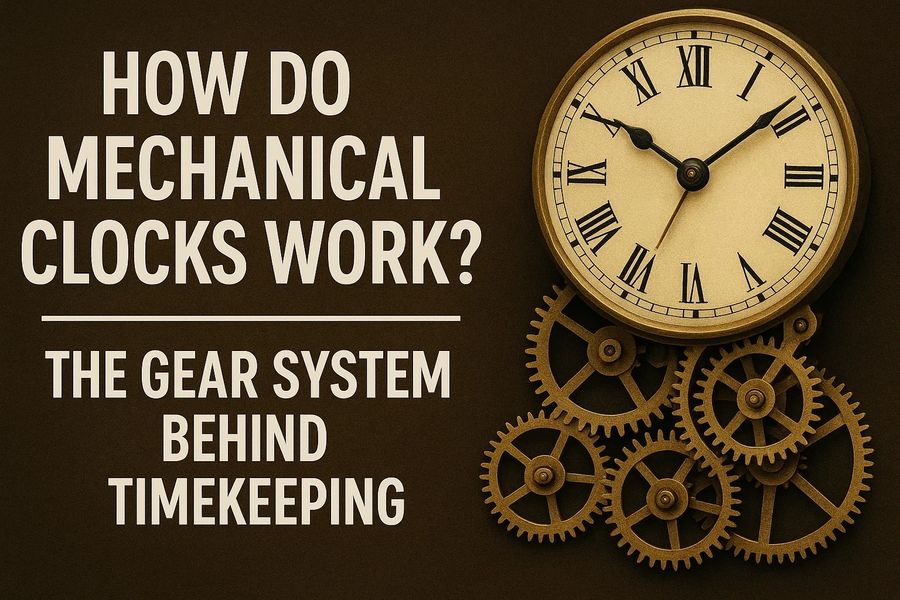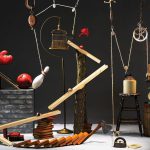Before digital displays and atomic timekeepers, the world relied on a marvel of human ingenuity — the mechanical clock. These clocks, some of which are still ticking centuries later, represent the fusion of art, engineering, and physics. Powered by springs or weights, and regulated by gears and escapements, mechanical clocks keep time using nothing but mechanical motion.
Let’s wind back the gears and explore how these timeless machines work. 🕰️🛠️
🧭 A Brief History of Mechanical Clocks
Mechanical clocks date back to medieval Europe in the 13th century. Before that, people used sundials, water clocks, and candle clocks, which lacked precision and were dependent on environmental factors. The invention of the mechanical clock revolutionized timekeeping by allowing people to track time independently of nature.
By the 17th century, the addition of pendulums and spring-driven mechanisms improved accuracy dramatically. These devices were essential in everything from navigation to church rituals and industrial work schedules.
🛠️ The Core Components of a Mechanical Clock
A mechanical clock works by carefully regulating stored energy through a series of interconnected mechanical parts. Here’s what makes up the heart of the system:
1️⃣ Power Source: The Energy Supply
-
Weight-Driven Clocks: Use gravity to pull a weight downward, turning gears. Common in tower clocks. 🪨
-
Spring-Driven Clocks: Use a wound mainspring to store potential energy. Common in wristwatches and compact clocks. 🌀
These sources store energy that’s gradually released to power the movement of the hands.
2️⃣ Gear Train: The Time Divider ⚙️
The gear train is a series of gears that reduce or multiply speed, converting the fast movement of the energy source into controlled, slow motion for the clock hands.
-
Translates fast spring unwinding into slow, consistent motion.
-
Divides time into hours, minutes, and seconds.
-
Gears are carefully ratioed to maintain consistent intervals (e.g., 60 seconds per minute).
Each gear in the system interlocks precisely to divide motion across different axes of time.
3️⃣ Escapement: The Regulator 🧩
The escapement is the mechanical brain of the clock. It ensures that energy is released in even, regulated intervals.
-
It consists of:
-
Escape Wheel
-
Pallet Fork
-
Anchor or Lever
-
The escapement gives a “tick-tock” motion and controls how the gear train moves forward step-by-step. It allows the gear train to pause briefly and then advance, preventing the clock from unwinding all at once.
4️⃣ Oscillator: The Timekeeper 🎯
The oscillator is what regulates the escapement. It’s a part that moves back and forth at a consistent rate.
-
In pendulum clocks: a pendulum swinging back and forth ⛓️
-
In balance wheel clocks: a spring and wheel combination, especially in portable timepieces 🕊️
The regular oscillation ensures that the gear train advances in precise intervals, making the passage of time accurate.
5️⃣ Display Mechanism: The Clock Face 🕰️
Finally, the motion is transmitted to the clock hands via another set of gears:
-
Hour wheel
-
Minute wheel
-
Second wheel (if present)
These gears rotate the hands across the face of the clock in correct proportion:
60 seconds → 1 minute → 1 hour → 12 hours
🔄 How the System Works Together
Let’s summarize the flow:
-
Energy Source: Wound spring or falling weight powers the clock.
-
Gear Train: Transmits motion and divides it for seconds, minutes, and hours.
-
Escapement: Controls energy release in even pulses.
-
Oscillator: Regulates timing of the escapement.
-
Display Mechanism: Translates gear movement into hand rotation.
The balance between these components allows a clock to tick with near-perfect consistency — an incredible feat of purely mechanical design!
📏 Ratios That Keep Time
The gear train’s effectiveness depends on precise gear ratios. For example:
-
The second hand rotates once per minute.
-
The minute hand rotates once per hour.
-
The hour hand rotates once every 12 hours.
To achieve this:
-
The gear ratio between the second and minute hand: 60:1
-
Between minute and hour hand: 12:1
These are achieved through a network of carefully placed pinions (small gears) and wheels (larger gears).
🧠 Mechanical Accuracy: What Influences It?
Mechanical clocks are subject to several factors that can affect accuracy:
-
Friction and Wear: Gear teeth wearing down changes timing.
-
Temperature: Affects spring tension and pendulum length.
-
Position: Gravity can influence pendulum swing or spring dynamics.
-
Lubrication: Lack of oil causes resistance in gears.
Modern digital clocks aren’t affected by these, but for their time, mechanical clocks were technological masterpieces capable of daily accuracy within a few seconds to minutes.
🏛️ Famous Examples of Mechanical Clocks
Here are some historically significant mechanical timepieces:
-
Big Ben (UK): Uses a gravity-driven escapement and massive pendulum.
-
Prague Astronomical Clock: Built in 1410, still running today!
-
Antikythera Mechanism: An ancient Greek clockwork calculator.
-
Marine Chronometers: Used in the 18th century to solve the problem of finding longitude at sea.
These clocks weren’t just tools — they were symbols of technological progress and craftsmanship. 🏆
🧮 Mechanical Clocks vs. Digital Clocks
| Feature | Mechanical Clocks | Digital Clocks |
|---|---|---|
| Power Source | Weights or springs | Battery or electricity |
| Mechanism | Gears and escapement | Quartz oscillator, CPU |
| Accuracy | Moderate (1–2 min/day deviation) | High (1 sec/month or better) |
| Maintenance | Requires winding, oiling | Minimal maintenance |
| Longevity | Centuries with care | ~10 years (average lifespan) |
| Aesthetic Value | High (collectible, decorative) | Low to moderate |
🔮 The Future of Mechanical Timekeeping
Though digital timekeeping is ubiquitous, mechanical clocks and watches remain popular among collectors, enthusiasts, and artisans. Brands like Rolex, Patek Philippe, and Omega continue to craft mechanical watches that blend precision with art.
Modern innovations include:
-
Tourbillons: Rotating cages that reduce the effects of gravity.
-
Perpetual Calendars: Account for leap years and varying month lengths.
-
Hybrid Clocks: Combine mechanical movement with smart tech.
Mechanical timekeeping is no longer just practical — it’s philosophical, reflecting human fascination with the passage of time and our ability to harness it.
🧾 Conclusion
Mechanical clocks are an elegant testament to human engineering and craftsmanship. By using weights or springs, gears, escapements, and oscillators, they measure time through a symphony of moving parts. Each “tick” and “tock” is a tiny moment of energy conversion and precision — a whisper of centuries-old ingenuity still echoing in homes, towers, and wrists today. 🕰️💡
Whether you’re marveling at a grand grandfather clock or winding a classic watch, you’re engaging with a mechanical miracle built on gears, gravity, and genius.


